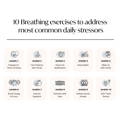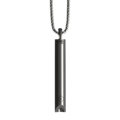
Stress Better in 4 Steps
Can we anticipate and prepare for stressful situations?
Can we prevent stress? At least some of it?
Can we develop a stress toolkit that will help us in stressful situations?
Yes. 100%.
Why should you read this?
As we prepared to launch our stress breath course,I realized I was still pretty terrible at dealing with stress. I would like to be better at being stressed.
I was actually hoping there was some magic somewhere that I could learn to eliminate stress, but our resident therapist and cofounder DA assures me that no such magic exists.
Through our interview, here’s what DA helped me understand:
Thanks for reading,
Aaron.
Step 1: Accept that stress is normal & can be good for us.
The first step is to accept that stress is a natural and unavoidable feature of life, and it can actually have a positive impact on our day to day and long-term growth and resilience.
But, this comes with a caveat: stress can be good for us if we are able to corral and manage it.
The net impact of stress comes down to our understanding of stress, our relationship with it, and how well we are able to balance good stress and bad stress.
Good stress propels us forward. It gives us purpose and helps us find things meaningful and challenging. Good stress leads to fulfillment.
Bad stress slows us down and wears us out. It is overwhelming and disorienting and mixes up our priorities. Bad stress leads to exhaustion and illness.
Step 2: Understand stress flow states & our nervous system.
Ok, the first step is acceptance. Stress is here to stay.
The second step: awareness. If we can understand the basics of stress, we can begin to understand how to turn it down and how to see it coming.
We are designed to see stress in our environment and react. And our body’s stress response helps with this.
There are two types of stress flow states.
Stress flow state example #1.
Stress flows into our bodies from the environment, stress is perceived by the body, we react, we eliminate the stress, and it flows through us.
For example: we see a bear in the wild, we get cut off while driving, we get into an argument with a loved one.
Stress flow state example #2.
We generate a stressor within us, stress is perceived by the body, we react, we struggle to eliminate the stressor because we are generating it ourselves, but the stress still flows out into the environment.
For example: we’re in a meeting at work or a conversation with a colleague or watching the news, we hear something we don’t like, we start to imagine some scenarios that may or may not happen and continue to ramp up the stress response. As the internal stress increases, it flows from us into the environment. All before we really know what’s happening.
The amazing thing about stress and our bodies: we are in control, not the stress.
Everything a bear?
This is when we are so stressed out that our body encounters the smallest stressor and reacts as if there is a giant, famished, snarling bear in the room with us. Needless to say, not a good spot to be in.
How does stress impact our nervous system?
The nervous system is a physical thing, a real thing that exists inside our bodies. It is impacted by what is happening elsewhere within our bodies and by our environment. The nervous system affects how we physically feel and in turn impacts every little nook and cranny in our bodies. It is connected to all our organs, it monitors our heart rate, it causes butterflies in our stomach, it interprets sensations and emotions and perception.
The nervous system is an incredible network of highways, roads, one-way streets, cul-de-sacs, alleys, sidewalks, and more.
Ok, yeah, not exactly breaking news, right?
This may feel like old news, but it’s important to acknowledge and reinforce this fact because it places us in the driver’s seat.
When we understand the nervous system is within us, we begin to understand we are in control, we have agency, we can influence what the nervous system does and we can use it to uplift our bodies and energize ourselves, or we can use it to downshift and calm our bodies.
We can’t control our environment or outside stimuli or even our reactions to all of this to a certain point. But, we can control our nervous system.
Can we control our nervous system?
Most people think they cannot control their nervous system.
We’ve talked a bit about the inhale as the gas pedal and exhale as the brake.
When you understand that you are able to control your nervous system, you’ve just completed the puzzle and put your hands on the steering wheel.
We’re ready to take this body of ours for a drive.
When we drive, we’re constantly scanning the external environment and the road ahead for signs, potential danger, turns we need to make, pedestrians, and more.
But we also need to scan the internal dashboard to make sure that we’re going the right speed, that we have enough fuel, that the check engine light isn’t on.
Many of us are only scanning the external environment because that is the area outside of our control, which induces fear. We can’t predict with any certainty what might happen on the road ahead. We believe we are subjected to the happenings of the world around us. So we place a majority of our attention on the external.
But by scanning our internal systems, by paying attention to our dashboard, we can take control of stressful situations. And, get better and better at anticipating stress and dealing with it before it becomes overwhelming.
"Stress is not necessarily a bad thing. In fact, it can help us grow."
Step 3: Intervene, then prevent (some) stress.
There are some very basic, universal things we can all rely upon when those stressful moments show us.
Need immediate intervention?
Pay attention to your breath, slow down the exhale, turn off your body’s stress response.
Feeling stuck?
Get up, go outside, walk around, look up.
If we can accept that we are stressed out, we are making progress.
If we can say to ourselves, I am not a stressed out, anxious person, I am experiencing a stressful situation, we can begin to separate ourselves from the stressors.
If we can ask ourselves some of these questions, we can identify sources of stress, both conscious and subconscious, and then prepare for stress:
- How am I sleeping?
- When was the last time I went for a walk?
- When was the last time I wrote down my stressors?
- Have I been drinking water?
- What have I been eating
- Do I have a plan for today? Tomorrow?
- Have I been taking my medications consistently?
- How am I speaking to myself?
- How am I speaking to others?
- Am I relying on an escape like video games, alcohol, drugs?
- When was the last time I called or met up with a friend?
- What is my stress trying to tell me?
If we can make a habit of these steps, we can prevent some stress, and be much better prepared for the stress when it shows up.
Step 4: Prepare with stress customizations.
There are those universal aids we can all turn to when stress is overwhelming.
There are those universal things we can all do consistently to help us prevent some stress, such as journaling, exercising, breathing and more.
But then there are also those very personal, very specific things we like to do that can help us deal with stress. Let’s call these stress customizations.
There are some things you can’t change, right? We have rules. You have to walk on two feet. You have to go to work. You cannot get out of dealing with stress in life. And as we mentioned above, stress can be good. So we don’t want to fully eliminate it.
But when we can anticipate stress, and prepare for it, and consistently embrace stress, we can control it and use it to our benefit.
Imagine your body as a house.
You can’t knock down the walls or get rid of the roof, but you can move some things around and make some customizations.
You can change the color of the paint, you can leave the doors and windows open, you can turn the lights on and off, you can buy new lights, you can sit on the couch or lie in bed or walk in the backyard or cruise down the street.
When we pay attention to where stress pops up, and pay attention to where it recedes, we can create specific daily customizations that will help us deal with stress more efficiently.
Maybe you like puzzles, or music, or video games. Maybe you like a good power nap, maybe you read, maybe you sip on coffee and space out. Whatever that stress customization is, get really good at it, and make it a part of your daily routine and you not only prepare for stress, you can prevent (at least some of the bad) stress.
The Shift Collection
Read more blog posts...




